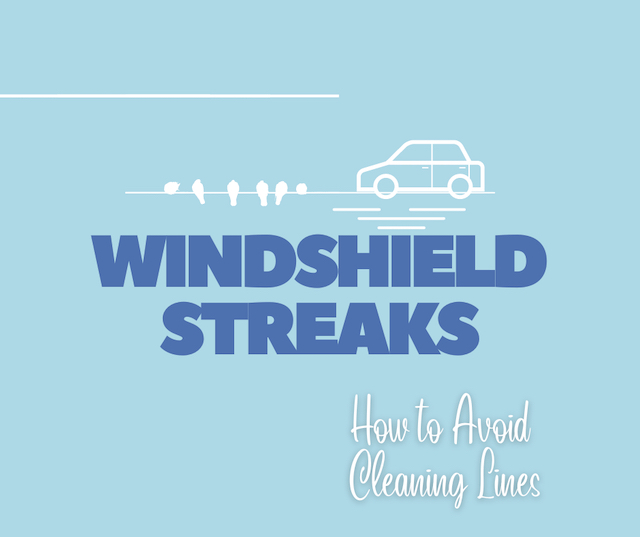Cleaning your auto glass is a chore. A chore enough, plenty of people pay other businesses to clean their cars and auto glass for them. The act of washing and polishing your entire vehicle exterior, especially during frigid winters, is enough of an arduous task. It can already be difficult to get the cleaning process started. So once you finish your chore and find that your windshield still has streaks on it, you may find yourself in a pit of despair.
Is all hope gone? Did I just clean my glass for no reason? What opposing force struck this never-ending chore upon me?
Simply put, the winding and distracting streaks that are left over on your windshield after cleaning it can be annoying. Though you attempted to clean your glass to improve your driving vision, you are still left with a visible obstacle. Your future is not as bright as the light you shone upon it.
As windshield experts, we know a thing or two about cleaning streaks. All in all, they suck. So, how do you prevent them while cleaning? Is there some magical formula that will prevent the obstruction?
Let’s get into it!
What Are Window Streaks?
We wish we could point to a universal solution for window streaks, but the array of causes is wide. Ultimately, you can sum the cause of the lines up to the cleaning liquid itself. It’s a liquid that has left a residue on your auto glass, creating a sticky or crusty line due to the rolling of the liquid drop. Why exactly this happened depends.
Here are the most common causes of the streaks:
- Sunny days: most commonly, the lines are caused by the cleaning liquid drying before you get a chance to wipe them away. This quick drying is usually due to direct sunlight or excessive heat. Once the liquid dries, the line is formed.
- Too much: if you use too much liquid, it may be impossible to wipe it all away. This will allow leftovers to dry and create lines. Furthermore, a solution with too much soap may create a sticky residue.
- Hard water: common water from wells and city water systems is often considered hard. Therefore, it contains an excess level of dissolved minerals like calcium and magnesium. If you are using normal water (i.e. your hose), it’s likely you are leaving minerals on your glass. Once it dries, it leaves streaks. Denver is considered to have moderately hard water.
So, How Do You Avoid the Windshield Streaks?
We’re glad you asked.
While the cause of windshield streaks may vary, the avoidance of them doesn’t stretch far. By following a few simple steps, you should eliminate any possible factor that causes the residue. Therefore, it’s easy to break down a few avoidance tips.
At the end of the day, avoiding windshield streaks comes with experience. Once you’ve become an expert on cleaning your specific car, you should find a way of prevention that works for you (and your vehicle). If one of these methods doesn’t work, keep trying different combinations to squash those lines.
Use the Right Supplies
First of all, let’s get this out of the way. Always use a microfiber cloth. Make sure that it is clean and doesn’t have any debris stuck to it. Avoid paper towels and normal cloth. Microfiber gives you the best possible clean without the chances of hurting your windshield. No one wants windshield damage.
Regarding what cleaners to use, mileage may vary. Most cleaning formulas advertise as ‘streak free’. Unfortunately, this usually isn’t the case. Obviously, the pricier automotive-specific glass cleaners are better than your household (and cheap) cleaners, but the price may scare some away.
On the other hand, some people swear by the at-home formula of white vinegar and alcohol. They mix together the following ingredients in a spray bottle:
- 2 cups distilled water
- 1/2 cup white vinegar
- 1/4 rubbing alcohol
Finding which cleaner works for you will take some time. We recommend going straight for the at-home mixture, but you may want something more significant and specialized if you have extreme buildup.
Wipe Correctly
Overall, this is where most people mess up, creating those pesky streaks. How you approach cleaning your windshield (and auto glass) is the most important part of avoiding residue.
Pour or spray the cleaner directly on the rag, not the windshield. Spraying on the windshield may allow it to dry too quickly, causing streaks. Furthermore, going directly to the windshield may cause too much solution, also causing streaks. Spray on the rag.
Only clean one window at a time. This may seem obvious, but some of us are easily distracted, flying around the vehicle while cleaning various parts. — Me included.
Wipe the solution away in a top-to-bottom motion, no swirling or side-to-side. Think like the window cleaners you see on buildings. They move the squeegees from the top to the bottom, take the squeegee off the bottom, and restart at the top. Swirling or repeating over lines may increase streak chances.
Remember: wipe the solution off before it dries! Drying incorrectly is the main cause of streaks.
Choose Your Battles
As we stated earlier, direct sunlight or especially dry days (hello, Denver) can cause the solution to dry too quickly, creating residue. Therefore, cleaning your windshield is actually easier on cloudy or humid days.
While the idea of cleaning your car on a cloudy day may seem like a drag, it’s actually more beneficial overall. Sure, you may not pick up that accompanying suntan, but your car will look cleaner. Pick and choose.
Furthermore, it’s important to remember that Denver water tends to be harder in the colder months. During the winter, waterways and reservoirs freeze, allowing the water to absorb more minerals. It becomes softer from late spring through early fall when the runoff dilutes down some of the minerals. Therefore, you actually have an increased chance of windshield streaks when cleaning during the winter (unless you aren’t using your home’s water).
More Detailed Cleaning Instructions
- Avoid placing your vehicle in the sun while cleaning, if possible. Direct sunlight will cause the cleaning supplies to evaporate quicker. It may lead to a less-than-desired result during your cleaning process. Work smarter not harder, after all.
- Make sure to pull your windshield wipers up before cleaning; this will allow maximum reach on all of your dirty glass and help avoid damaging your blades.
- If there is an excess of grime that will not spray away, take the time to polish it out with liquid car cleaner or diluted dish soap.
- Spray half of your windshield with your auto glass cleaner. While it’s okay to spray it all, keeping direct attention on one half of the windshield will help you avoid dry streaks on the other side.
- Start wiping in a vertical motion. Use your microfiber cloth to clean the windshield with downward strokes. Make sure to not leave any part unwashed.
- After finishing the vertical movement, begin wiping horizontally towards yourself. Meaning, wipe outwards towards the side of the car. It will help bust any remaining dirt and remove any vertical streaks.
- Repeat if necessary. There is no danger in using too much auto glass cleaner. Continue the process if you have to. Afterward, allow the glass cleaner to dry. There is no need to wash it off.

